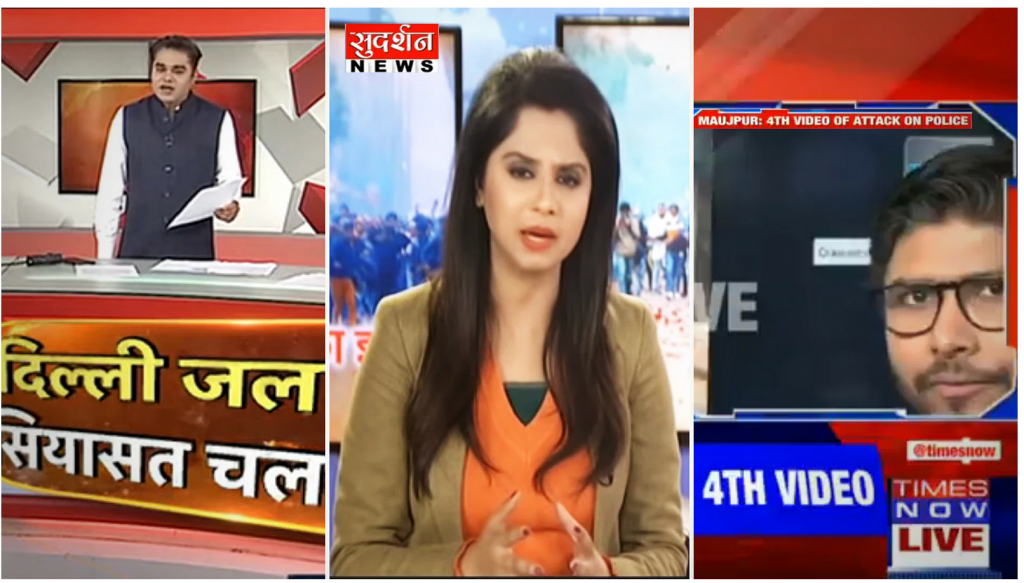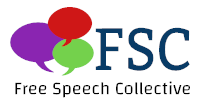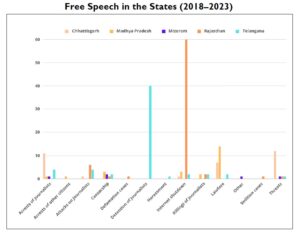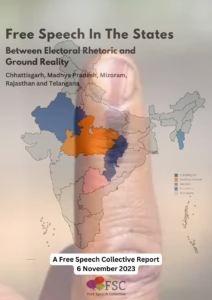“Uncertain Justice: A Citizens Committee Report on the North East Delhi Violence 2020”, authored by a five
member group comprising retired judges and civil servants gives the Committee’s findings on factors that contributed to the build-up to violence, features of the violence itself, the role of sections of the media and use of social media,
and legal analysis of the Delhi Police’s investigations into the violence since 2020.

Part II of the report “Examining Hate on TV News Channels and Social Media Platforms has important findings for the media. The Committee conducted an empirical analysis of the messaging of sections of the television media around
the CAA and the protests. This focuses on episodes aired in December 2019-February 2020 of primetime
shows of the six most viewed television news channels. These were Republic and Times Now (English), and
Aaj Tak, Zee News, India TV, and Republic Bharat (Hindi). We also examined relevant posts on various social
media platforms. The analysis reveals that the channels’ reportage of events surrounding the CAA framed
the issues as “Hindus versus Muslims” with prejudice and suspicion against the Muslim community. These
channels concentrated on vilifying anti-CAA protests, fanning unsubstantiated conspiracy theories, and
calling for their forcible shutdown.
In its broader takeaways, the executive summary of the report observes:
Sections of the media play a key role in propagating hateful narratives, illustrated in small part through
the study in the report. Their audience of daily watching households, as well as their social media presence,
ensures that the hateful narratives reach a very wide number. Clearly, any oversight exerted by the existing
broadcasting oversight bodies pales in proportion to the channels’ reach and leeway. For all of its benefits
as an unregulated space for speech and expression, this precise quality of social media presents serious
dangers as a carrier of rampaging hate speech and violent content. The need to regulate deeply harmful
content on social media, while retaining the free space it offers, is one of the most urgent challenges of our
times.
FSC brings you the conclusions of the two sections in the report. Scroll down to read the full report.
Troubling Dualities: News Media as Arbiter of Fact or Platform of Hate?
Conclusion
The analysis above reveals and substantiates the recurring narratives being projected by these shows/
channels during the period studied in this report. Anti-Muslim prejudice is a running thread through the
conjoined narratives attempting to cast anti-CAA protesters, Shaheen Bagh particularly, as conspiratorial
and violent. Expressions of prejudice, stereotypes, hyperbole, and baseless comparisons underpinned the
claims made.
The open accusations of criminality made against anti-CAA protesters, first as a block, and then against
individuals, were highly irresponsible, particularly given the extent to which accusations were shaped and
spread. In a signal of the gravity, the Delhi High Court was compelled to give stern warnings against the
conduct of any kind of “media trial” and directed the police to stop leaking documents or leads in cases
concerning individuals to media sources.
The language of anchors and panelists, and the phrasing of the visual tools on these shows, reveal the
antagonistic messaging and sensationalist style. The analysis above illustrates how anchors and panelists
used insulting, pejorative words – terrorist, jihadis, dangaiyon (rioters), traitors – to describe Muslims as
violent and anti-national. Anchors and panelists repeatedly referred, dismissively, to Muslims as “they” or
“these people”, alluding to a supposed unified “they” as a religious block with designs against Hindus or
the country. In tandem with hostility towards the Muslim community was the equation of the supposedly
violent and conspiratorial nature of the anti-CAA protest movement and protesters. Again, antagonistic
terms were coined and repeated – “tukde-tukde gang”, “danga brigade”. There were repeated instances where
panelists used such offensive terms or expressed calls for violence, with no rebuttal from the anchors to
challenge misrepresentations or denounce the violent calls.
The titles, flashing text and hashtags used in the episodes provide further evidence of the themes identified
and are also telling of semantic tools being used to shape and reinforce problematic messaging. Many
episode titles were phrased as rhetorical questions. The content of titles and flashing text were sensationalist
in tone and geared to provoke viewers. As has been pointed out, hashtags too were sensationalist in tone,
often offensive and misleading in facts. They added to the narratives being shaped for repetition and
consumption on social media.
Further, there was a fundamental disjunct between the narratives of violence, conspiracy and Islamic
radicalization being pushed by these shows/channels, and the publicly stated positions of the protest
movement. An honest interaction with the positions of the protest movement would have necessitated
recognizing that the protesters were opposing CAA-NRC for making their citizenship rights insecure. The
refusal to engage with the stated position of the protests also prevented these channels from providing an
informed and journalistically defensible critical commentary on different facets of the protests, if that was
the channels’ intended objective.
The uncanny similarity in rhetoric, messaging and even semantic style across these shows/channels is
revealing. Whipping up an enraged environment, planting ungrounded fears of the anti-CAA protests, and
creating vindictiveness against the Muslim community, where a forceful end to the protests may appear
valid, appear to be the larger outcomes being pursued.
Historically, violence has remained a troubling feature of mass protests, and other form of mobilizations.
Media reporting on it needs to be nuanced and responsible, and oriented by facts that shed light on all
elements that have contributed to violence, including the use of excessive and violent force by the police.
A sensationalist discourse, aimed at stigmatizing the otherwise legitimate features of a cause, serve to
make media channels a party to the conflict. This encourages an environment of vigilantism or even create
permissive conditions for high-handed state responses. It is critical that news organizations strictly follow
journalistic rules of rigor and objectivity in reporting on violence of any kind, and refrain from projecting
generalized judgments that malign one group or community. The failure of the existing regulatory
frameworks to act as a check is starkly exposed through this analysis.
Social Media as a Vehicle for Hate Speech
Conclusion
It is crucial for the parent companies of social media platforms to prioritize safeguarding against the
multiplier harm emanating from the platform’s mass use. The Indian context reveals that hate speech,
biased narratives, and hate crimes, both at the personalized level for users as well as at societal levels, are
intimately linked. The recent exposures of hate apps created to auction Indian Muslim women online are
a serious indication of the extent to which bigotry and hate can manifest online in various forms, fueled
by technology.644 The examples above, as well as continuing revelations through independent research,
such as on WhatsApp, are a stark reminder that the use of social media platforms are often part and parcel
of episodes of violence, whether through spreading false rumors, circulating offensive inciting tropes, or
facilitating the conduct of violent acts.
Social media is in dire need of a transformation in technological aspects and ramped up regulation to
mitigate against socio-political harm.645 The penal provisions in Indian laws have not been updated to
adequately deal with hate speech spread through Internet and social media mediums. No doubt, any
planning of increased regulation must preserve digital and freedom of expression rights. Also, it should be
ensured that government does not overreach regulation through greater controls that veer into censorship
or silence free speech, or violate the right to privacy.
Download the report here:
About the report:
The Constitutional Conduct Group (CCG) is a group of former civil servants belonging to the All India and Central Services who have worked with the Central Government as well as different State Governments of India. We work towards fostering a civic culture bound by the ethos of the Constitution of India. As a group we are not affiliated to any political party as we strongly believe in being impartial.
Following the riots in North East Delhi in February 2020, a small group of members of the CCG visited some of the affected areas and later wrote to the President of India asking for a judicial enquiry. Considering the horrific nature of the riots, the scale of violence, the loss of lives and the resulting communal divide between communities, we felt that an expert body should carry out a thorough examination of what transpired before, during and after the riots.
We invited a group of retired judges and civil servants with proven records of public
service to take on this task. The Citizens Committee comprised:
a. Justice Madan Lokur, former judge of the Supreme Court. (Chairperson)
b. Justice A.P. Shah, former Chief Justice of the Madras and Delhi High Courts
and former Chairman, Law Commission of India
c. Justice R.S. Sodhi, former judge of the Delhi High Court
d. Justice Anjana Prakash, former judge of the Patna High Court
e. G.K. Pillai, IAS (Retd.), former Home Secretary, Government of India
f. Dr. Meeran Chadha Borwankar, IPS (Retd.), former Director General, Bureau
of Police Research and Development, Government of India
Dr. Meeran Chadha Borwankar withdrew from the Committee when its work was
nearing completion.
(Constitutional Conduct Group)
Email: constitutionalconduct@gmail.com
Website: www.constitutionalconduct.com
Facebook: Constitutional Conduct
Twitter: consticonduct


